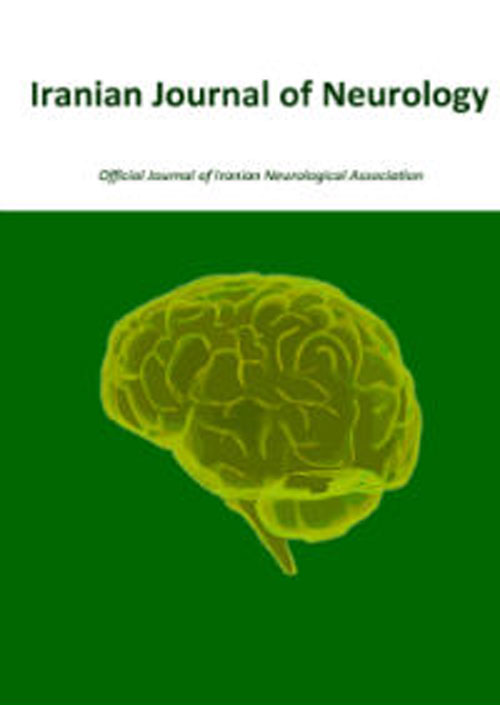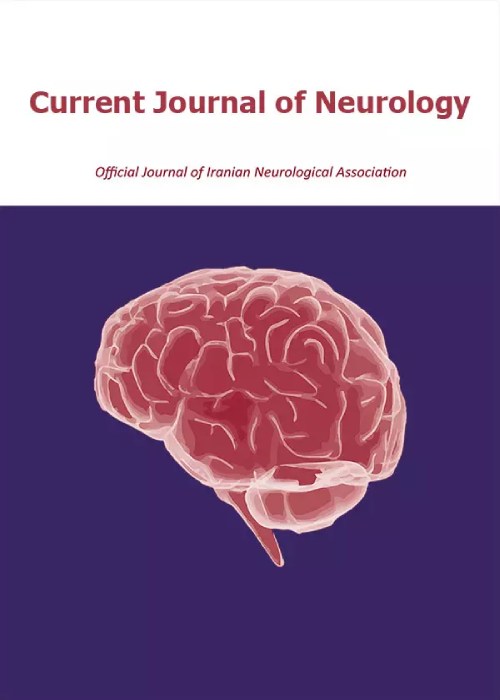فهرست مطالب

Current Journal of Neurology
Volume:17 Issue: 2, Spring 2018
- تاریخ انتشار: 1397/04/21
- تعداد عناوین: 10
-
-
Pages 58-63BackgroundNeuromyelitis optica spectrum disease (NMOSD) is a chronic inflammatory demyelinating disorder that involves central nervous system (CNS) with high affinity for involvement of optic nerve and spinal cord. In current study, due to high prevalence of NMOSD in Isfahan, Iran, we have aimed to assess brain and spine magnetic resonance imaging (MRI) of patients with NMOSD.MethodsThis cross-sectional study was performed on 62 patients with diagnosis of NMOSD, who referred to MS clinic of Kashani hospital, Isfahan City, during 2015-17. Patient's age, age of onset, primary brain and spine MRI findings, and expanded disability status scale (EDSS) were recorded in check list. Patients underwent new brain and spine MRI. Data were analyzed with SPSS software. Descriptive data were reported by mean ± standard deviation (SD).Results62 known cases of NMOSD including 9 (14.5%) men and 53 (85.5%) women with mean age of 34.32 ± 10.26 years, mean age of onset of 28.03 ± 12.09 years, and mean EDSS of 2.63 ± 1.55 were assessed. 33.9% of patients were anti-neuromyelitis optica (NMO) antibody seropositive. Longitudinal extensive transverse myelitis (LETM) and segmental spinal lesions were found in 66.1% and 29.0% of patients, respectively. Diagnostic NMO brain lesions and posterior periventricular lesions were seen in 38.7% and 67.7% of patients, respectively. Two patients had tumefactive lesions.ConclusionIn current study, we found high rate of posterior periventricular lesions in brain MRI and segmental lesions in spine MRI of both anti-NMO antibody seropositive and seronegative patients. As these lesions are not in NMOSD diagnosis criteria, more considerations are recommended. In addition, tumefactive lesions in patients with NMOSD were an exciting finding of this study that should be discussed about more.Keywords: Devic Disease, Neuromyelitis Optica, Magnetic Resonance Imaging, Demyelinating Disease, Cervical Spine
-
Pages 64-70BackgroundSince most patients with relapsing-remitting multiple sclerosis (RRMS) are women, the present study aimed to determine whether treatment of patients with MS by cytotoxic agents is associated with an increased risk of cervical dysplasia. Cancer screening is often neglected in the chronic diseases such as MS, so more attention in this field was needed. Decreasing morbidity and mortality due to cervical cancer is the most important goal of screening in female MS patients especially in child bearing age. Thus, it can be said that this is the first study which investigated this important issue.MethodsA total of 129 individuals participated in this cohort study. They were assigned into 3 groups including 43 patients with MS who were treated with cytotoxic drugs, 43 patients with MS on immunomodulators, and 43 normal healthy controls. Pap smears were performed following standard methods and the results obtained from the three groups were compared by statistical analysis. Demographic data, Expanded Disability Status Scale (EDSS), and Pap smear changes were analyzed by SPSS software.ResultsThe most commonly detected abnormality in all examined patients and healthy controls was inflammation. Five patients with MS who were treated with cytotoxic agents revealed benign cellular changes (BCC) in their Pap smear that were statistically significant in comparison with other groups (P = 0.03). Patients who took Mitoxantrone presented BCC more than other groups [Odds ratio (OR) = 9.44, 95% confidence interval (CI): 1.46-60.70]. There was no significant difference between mean duration of MS diagnosis (P = 0.12), mean duration of previous MS treatments (P = 0.25), and mean duration of current MS treatments (P = 0.21) in patients with BCC compared to normal healthy controls or inflammatory change.ConclusionAccording to the results of present study, BCC is more frequently observed in patients with MS who were treated with cytotoxic agents with immunosuppressive effect. Since BCC is a premalignant condition, the authors suggest that mandatory annual Pap smear should be performed for patients with MS who are treated with cytotoxic agents irrespective of their age in order to detect early signs of malignancy.Keywords: Pap Smear, Multiple Sclerosis, Cytotoxic Agents
-
Pages 71-77BackgroundParkinson's disease (PD), the second most prevalent neurodegenerative disorder, has been related with weight loss and energy balance. Some studies showed that leptin might be playing an important role in satiety, energy balance and immune response. The aim of this study was to evaluate serum leptin level in patients with PD and its association with clinical severity.MethodsIn this cross-sectional study, 35 patients with PD and 51 healthy controls (HCs), matched for age, sex and body mass index (BMI), were recruited. Serum leptin level was measured and clinical characteristics and demographic data of patients were recorded.ResultsThe mean age of patients with PD and HCs were 59.80 ± 11.40 and 62.18 ± 11.60 years, respectively. Serum leptin concentration was not statistically different between patients with PD and HCs (21.1 ± 23.1 ng/ml vs 25.9 ± 21.8 ng/ml, P = 0.280). There was no relation between plasma level of leptin and clinical severity of patients with PD.ConclusionOur findings suggest that serum level of leptin is neither implicated in the pathogenesis of PD, nor decreases as disease progresses.Keywords: Parkinson Disease, Leptin, Iran, Parkinsonism
-
Pages 78-81BackgroundEmotional intelligence refers to a process through which an individual is not only capable of understanding his/her/others emotions, but also is able to manage them. Emotional intelligence can get disturbed due to different neurological diseases. Since cognition and emotion are directly and closely related, the present study aims to evaluate the relationship between emotional intelligence and cognitive disorders in patients with Multiple Sclerosis (MS).MethodsThe demographic data of 92 MS patients participating in this study were recorded. The emotional intelligence and cognitive disorders were studied using the Bradberry-Greaves, and MS Neuropsychological Questionnaire (MSNQ) tests, respectively.Results16 men and 76 women were considered in this study. The mean age of the participants was 33.4 years, the mean duration of the disease was 6.8 years, the mean of Expanded Disability Status Scale (EDSS) was 1.97, the mean MSNQ was 21.58, and the mean emotional quotient (EQ) of the patients was 74.18. The MSNQ had a significant relationship with the total EQ and its sub-categories (PConclusionThis study showed that EQ and cognitive disorders are directly relevant to each other; as cognitive disorder increases, the EQ rate decreases. Therefore, cognitive rehabilitation might be effective in enhancing the EQ in these patients.Keywords: Emotional Intelligence, Cognitive Disorders, Multiple Sclerosis
-
Pages 82-85BackgroundPostoperative meningitis (POM) is the most dreaded cause of morbidity and mortality in neurosurgery patients. This study aimed to identify incidence and mortality rate as well as related factors to outcome in patients with POM.MethodsThis descriptive longitudinal study conducted on patients with POM in duration of 2 years. Incidence and mortality rates as well as related factors were studied.ResultsThe incidence and mortality rates of POM was 8.9% and 50%, respectively. There were statistically significant association between male gender, as well as having mechanical ventilation, and death outcome in univariable analysis. In addition, in multivariable logistic regression analysis, length of intensive care unit (ICU) stay of more than 7 days [Odds ratio (OR): 1.2, confidence interval of 95% (95%CI): 1.02-6.2), mechanical ventilation (OR: 1.1, 95%CI: 1.05-5.1], positive cerebrospinal fluid (CSF) culture (OR: 2.4, 95%CI: 1.9-4.08) were predicting factors to death outcome. Finally, we found an inverse relationship between survival function and length of ICU stay in patients with POM.ConclusionAccording to the high rates of incidence and mortality due to POM in this study, preventive studies to decrease this dreaded cause of morbidity and mortality in neurosurgery patients should be the planned.Keywords: Incidence, Mortality Rate, Related Factor, Postoperative Complications, Meningitis


